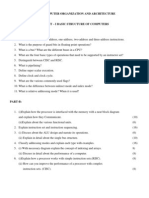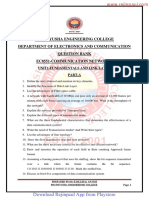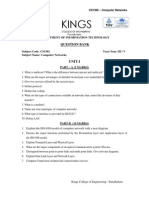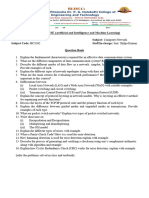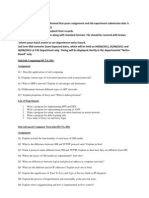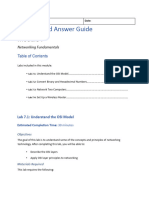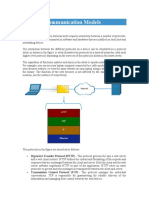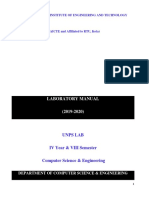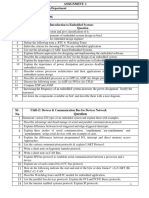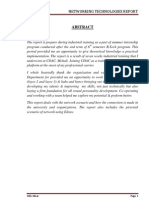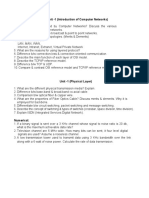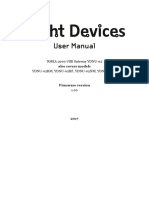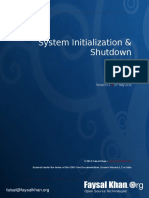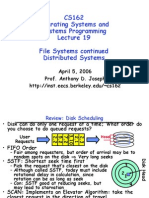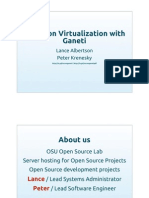LP II Mid Question Paper
LP II Mid Question Paper
Uploaded by
7killers4uCopyright:
Available Formats
LP II Mid Question Paper
LP II Mid Question Paper
Uploaded by
7killers4uOriginal Title
Copyright
Available Formats
Share this document
Did you find this document useful?
Is this content inappropriate?
Copyright:
Available Formats
LP II Mid Question Paper
LP II Mid Question Paper
Uploaded by
7killers4uCopyright:
Available Formats
VIDYA VIKAS INSTITUTE OF TECHNOLOGY II-MID Question Paper Banch & Year: III-IT,IV-CSE Subject: Linux Programming UNIT-I
1. Compare the IPC functionality provided by pipes and message queues.What are the advantages and drawbacks of each? Explain briefly. 2. Write a program and explain how to transfer a large amount of data between two processes using: (a) Pipes (b) Message queues. 3. What are the security problems associated with system V IPC mechanisms? 4. Write a program to illustrate client/server application using named pipes.
UNIT-II
1. Explain with a program how to copy file data from server to client using shared memory. 2. Explain the kernel data structure for shared memory with a neat diagram. Also explain the APIs associated for creating and destroying a shared memory. 3. What is Deadlock? Explain the situation when will the mutex lock creates a dead-lock condition within a process and also give the solution to prevent such deadlock condition. 4. Explain similarities and dissimilarities between the semaphore and shared memory IPC Mechanisms.
UNIT-III
1.What are the benefits of using multithreaded programming? 2. Explain the APIs used to specify the attributes for a thread. 3. What are the merits and demerits of multithreaded programming? 4. Explain the relationships of threads, LWPs and hardware processes with the help of a neat diagram.
UNIT-IV
1. Explain the sequence of steps to process various socket functions using TCP protocol.
2. Explain briefly about the following socket APIs with clear syntax:
(a) socket( ), (b) bind( ), (c) listen( ), (d) accept( ). 3. Describe all the elementary socket functions required to write a complete TCP client and server application. 4. Explain a stream socket with a illustrative example for client/server program.
You might also like
- Coa Important QuestionsDocument5 pagesCoa Important QuestionsGanesh Babu100% (2)
- Exploring BeagleBone: Tools and Techniques for Building with Embedded LinuxFrom EverandExploring BeagleBone: Tools and Techniques for Building with Embedded LinuxRating: 4 out of 5 stars4/5 (1)
- Minecraft Education Edition Multiplayer Guide 1Document8 pagesMinecraft Education Edition Multiplayer Guide 1Zack JNo ratings yet
- 07a7ec19 Network ProgrammingDocument4 pages07a7ec19 Network ProgrammingNaveen KumarNo ratings yet
- Question BankDocument9 pagesQuestion BankK R OFFSET PRINTERSNo ratings yet
- Emebbedd Question BankDocument25 pagesEmebbedd Question Banksujith100% (3)
- LP Important Questions: UNIT-6Document2 pagesLP Important Questions: UNIT-6Chandra Shekar Reddy TummuriNo ratings yet
- CS1302 - Computer NetworksDocument5 pagesCS1302 - Computer Networkslm_zakaria4420No ratings yet
- MCN Question Bank Mid SemDocument1 pageMCN Question Bank Mid SemSinley PatelNo ratings yet
- Computer Networks Ques BankDocument2 pagesComputer Networks Ques BankRajat PandeyNo ratings yet
- Computer NetworksDocument9 pagesComputer NetworkspriyaaramNo ratings yet
- PDF01Document1 pagePDF01ppavankumar9876No ratings yet
- CS2361 CN Im 2013 PDFDocument2 pagesCS2361 CN Im 2013 PDFsaravana102030No ratings yet
- Network ProgrammingDocument168 pagesNetwork ProgrammingNoorullah Shariff100% (1)
- CN MODIFIED QUESTIONSDocument3 pagesCN MODIFIED QUESTIONSજીવન અવિનાશ કનુગુલાNo ratings yet
- Experiments and AssignmentDocument3 pagesExperiments and AssignmentRITESH KUMAR PANDEYNo ratings yet
- Cisco Interview QuestionsDocument8 pagesCisco Interview QuestionsssprudhviNo ratings yet
- 514.LANMAN 1 Latest AssignmentsDocument4 pages514.LANMAN 1 Latest AssignmentsDennis MbaleNo ratings yet
- IT1353 Embedded SystemDocument6 pagesIT1353 Embedded SystemReeshma ApNo ratings yet
- Lab-8 W0851889Document27 pagesLab-8 W0851889aryansharma6No ratings yet
- Question Bank Unit 1-2Document3 pagesQuestion Bank Unit 1-2Vikas ManchalNo ratings yet
- Important Questions in Mobile Communication It2402 It 2402 Subject For NovDocument3 pagesImportant Questions in Mobile Communication It2402 It 2402 Subject For NovNivedhaSekarNo ratings yet
- Network Communication ModelsDocument7 pagesNetwork Communication ModelsFilipe NahorNo ratings yet
- HKBK College of Engineering Department of Computer Science & Engineering Bengaluru - 560045 Computer Network Security (18CS52) Module1 Question BankDocument1 pageHKBK College of Engineering Department of Computer Science & Engineering Bengaluru - 560045 Computer Network Security (18CS52) Module1 Question BankMohammed Salman M RNo ratings yet
- Assessment 03-1Document2 pagesAssessment 03-1hanagohar720No ratings yet
- 8cs5a Unps Lab Manual 1Document64 pages8cs5a Unps Lab Manual 1Rooparam ChoudharyNo ratings yet
- Assign 1Document1 pageAssign 1Brinda BMNo ratings yet
- As Es 2023-2Document6 pagesAs Es 2023-2Sneha GolakiyaNo ratings yet
- Assignment Questions - Internet TechnologyDocument2 pagesAssignment Questions - Internet TechnologyPradish DadhaniaNo ratings yet
- HP Course Structure 80 HoursDocument3 pagesHP Course Structure 80 Hourssumitsahu009No ratings yet
- What Do You Understand by Internet? List The Uses. What Does Protocol Layering Mean?Document20 pagesWhat Do You Understand by Internet? List The Uses. What Does Protocol Layering Mean?jagan19781978No ratings yet
- Project ReportDocument41 pagesProject ReportNupur Nidhi100% (1)
- CN Question BankDocument4 pagesCN Question BankSeemon BhadoriaNo ratings yet
- CS8581-Networks Lab Manual (2020-2024)Document50 pagesCS8581-Networks Lab Manual (2020-2024)john wickNo ratings yet
- SDFSDFSDFDocument42 pagesSDFSDFSDFoksana.skorykhNo ratings yet
- Opnet - Sec - 3Document16 pagesOpnet - Sec - 3Thangavel MuruganNo ratings yet
- DDCO QB 2Document2 pagesDDCO QB 2raishivanshu629No ratings yet
- Abstract On Socket ProgrammingDocument33 pagesAbstract On Socket Programmingyogesh_yadav2012100% (2)
- Question Bank Module-1: Computer Networks 18EC71Document4 pagesQuestion Bank Module-1: Computer Networks 18EC71richa100% (1)
- CNS-Super Important questions-18CS52Document3 pagesCNS-Super Important questions-18CS521JS19CS188 Vijay Naik0% (1)
- Ajp U-4Document15 pagesAjp U-4Ayushi JapsareNo ratings yet
- Computer Organization Ii Mid Question Bank Ii Cse Ii Sem UNIT-5Document1 pageComputer Organization Ii Mid Question Bank Ii Cse Ii Sem UNIT-5Vamsinath JavangulaNo ratings yet
- Embed SystemDocument4 pagesEmbed SystemMohan RajNo ratings yet
- Unit-I / Part-ADocument2 pagesUnit-I / Part-AShyam SundarNo ratings yet
- Ccnab PDFDocument100 pagesCcnab PDFLiberito SantosNo ratings yet
- Ns Question BankDocument18 pagesNs Question BankSOBANA RAJESHNo ratings yet
- Computer Networks Assignment 1Document1 pageComputer Networks Assignment 1tkNo ratings yet
- Unit - 1 (Introduction of Computer Networks)Document5 pagesUnit - 1 (Introduction of Computer Networks)Abhinavv GandhiNo ratings yet
- BCS 011 Previous Year Question Papers by IgnouassignmentguruDocument72 pagesBCS 011 Previous Year Question Papers by IgnouassignmentguruSharda RaniNo ratings yet
- BCS 011 Previous Year Question Papers by IgnouassignmentguruDocument78 pagesBCS 011 Previous Year Question Papers by IgnouassignmentguruSonam KumariNo ratings yet
- (MCQ) Computer Communication Networks - LMTDocument18 pages(MCQ) Computer Communication Networks - LMTraghad mejeedNo ratings yet
- IwipDocument34 pagesIwipapi-19937584No ratings yet
- 18it502 - DCCN - Question Bank-1Document6 pages18it502 - DCCN - Question Bank-1SHANMUGAM SNo ratings yet
- AsdfDocument18 pagesAsdfbalajiNo ratings yet
- Question Bank CompleteDocument5 pagesQuestion Bank CompleteSaurabh SenNo ratings yet
- Network Programming ImpDocument5 pagesNetwork Programming Impsharath_rakkiNo ratings yet
- BCS-052 NotesDocument4 pagesBCS-052 NotesAbhishek MandalNo ratings yet
- RPL Thesis ch2Document13 pagesRPL Thesis ch2Alex AliNo ratings yet
- Information Technology V Sem Set 2Document2 pagesInformation Technology V Sem Set 2aniruthgsabapathyNo ratings yet
- Cisco Certified Network Associate (CCNA) and Cisco Certified Network Professional (CCNP): Mastering Network Automation and Programmability Study GuideFrom EverandCisco Certified Network Associate (CCNA) and Cisco Certified Network Professional (CCNP): Mastering Network Automation and Programmability Study GuideNo ratings yet
- STM Q Paper 2-MidDocument2 pagesSTM Q Paper 2-Mid7killers4uNo ratings yet
- Vidya Vikas Institute of Technology: Chevella I - Mid QuestionsDocument1 pageVidya Vikas Institute of Technology: Chevella I - Mid Questions7killers4uNo ratings yet
- DMDW II-mid Questions: Unit-5Document1 pageDMDW II-mid Questions: Unit-57killers4uNo ratings yet
- IRSDocument1 pageIRS7killers4uNo ratings yet
- CG QuestionsDocument4 pagesCG Questions7killers4uNo ratings yet
- Main Pages Final - B.tech-CSEDocument5 pagesMain Pages Final - B.tech-CSE7killers4uNo ratings yet
- Certificate CseDocument1 pageCertificate Cse7killers4uNo ratings yet
- DM Lab ManualDocument32 pagesDM Lab Manual7killers4uNo ratings yet
- LPDM Lab ManulDocument89 pagesLPDM Lab ManulAnjali NaiduNo ratings yet
- LP Imp QuestionsDocument2 pagesLP Imp Questions7killers4uNo ratings yet
- Mid - 1 Questions IrsDocument2 pagesMid - 1 Questions Irs7killers4uNo ratings yet
- Linux Programming Lecture NotesDocument190 pagesLinux Programming Lecture Notes7killers4u79% (19)
- Uml Lab ManualDocument33 pagesUml Lab Manual7killers4uNo ratings yet
- Unit-I: Introduction To Information Retrieval SystemsDocument14 pagesUnit-I: Introduction To Information Retrieval Systems7killers4u100% (1)
- Software Testing Methodologies Question Paper For I-Mid (IV-I CSE & IT) Faculty B.Sunil SrinivasDocument1 pageSoftware Testing Methodologies Question Paper For I-Mid (IV-I CSE & IT) Faculty B.Sunil Srinivas7killers4uNo ratings yet
- Unit-4: Define The Domain For ClusteringDocument13 pagesUnit-4: Define The Domain For Clustering7killers4uNo ratings yet
- Gate 2 K 13 PosterDocument1 pageGate 2 K 13 Poster7killers4uNo ratings yet
- Case Tools & Software Testing Lab Manual (IV-CSE)Document63 pagesCase Tools & Software Testing Lab Manual (IV-CSE)Kamala GantaNo ratings yet
- Unit-I: Introduction To Information Retrieval SystemsDocument14 pagesUnit-I: Introduction To Information Retrieval Systems7killers4u100% (1)
- Operating System QuestionsDocument15 pagesOperating System Questions7killers4uNo ratings yet
- Unit-Ii: Cataloging and IndexingDocument13 pagesUnit-Ii: Cataloging and Indexing7killers4u100% (3)
- Introduction To Automatic IndexingDocument28 pagesIntroduction To Automatic Indexing7killers4uNo ratings yet
- Mobile Development: Application'S Life CycleDocument32 pagesMobile Development: Application'S Life CycleNgô Tiến ThiệnNo ratings yet
- FA2100 GROUND SUPPORT EQUIPMENT - L-3 Aviation RecordersDocument2 pagesFA2100 GROUND SUPPORT EQUIPMENT - L-3 Aviation RecordersBowser DoskaNo ratings yet
- Yusuf Maitama Sule University Kano Foculty of ScienceDocument4 pagesYusuf Maitama Sule University Kano Foculty of ScienceJamilu usmanNo ratings yet
- OrgPublisher 10 1 Installation GuideDocument53 pagesOrgPublisher 10 1 Installation GuidesriharshaiqssNo ratings yet
- NMEA 2000 USB GatewayDocument52 pagesNMEA 2000 USB GatewayAlexander GorlachNo ratings yet
- Appliance Control by RT-LINUXDocument21 pagesAppliance Control by RT-LINUXManikanta RobbiNo ratings yet
- 1694709735381Document1 page1694709735381ugorprecious3No ratings yet
- 13:45:53Document22 pages13:45:53Flores Ramos Paula JoanelyNo ratings yet
- Module 11: Implementing Group PolicyDocument39 pagesModule 11: Implementing Group PolicyUday VarmaNo ratings yet
- OS UNIX Exercises-4 v1.0Document1 pageOS UNIX Exercises-4 v1.0Deepak Kr SinghNo ratings yet
- Installing The Teleperformance Work at Home BYOD SoftwareDocument8 pagesInstalling The Teleperformance Work at Home BYOD SoftwareHiram Miguel Rabago QuiñonesNo ratings yet
- Configuring and Using Database Mail in SQL Server 2008 R2Document24 pagesConfiguring and Using Database Mail in SQL Server 2008 R2Roel Antonio PascualNo ratings yet
- Emu LogDocument5 pagesEmu LogErwin XuNo ratings yet
- System Initialization & ShutdownDocument13 pagesSystem Initialization & ShutdownFaisal Sikander KhanNo ratings yet
- OS TotalDocument50 pagesOS TotalHarisson Pham100% (1)
- EDT in SwingsDocument2 pagesEDT in SwingsShobha KumarNo ratings yet
- Version Overview: Release Notes Drivers and ToolsDocument8 pagesVersion Overview: Release Notes Drivers and ToolsPasha SiregarNo ratings yet
- X-Global Print DriverProduct Enhancements Document-5.759.5.0Document2 pagesX-Global Print DriverProduct Enhancements Document-5.759.5.0Abas AbdikadirNo ratings yet
- Debug 1214Document13 pagesDebug 1214Mohammed AminNo ratings yet
- MS4-2887 Rev.01 SOP-AR850 Installation ProcedureDocument61 pagesMS4-2887 Rev.01 SOP-AR850 Installation ProcedureVlada Zlatanović100% (1)
- Handout JCLDocument46 pagesHandout JCLShare&Enjoy100% (1)
- Lec19 Filesystems2Document30 pagesLec19 Filesystems2api-3761983No ratings yet
- ADAM-3600 FTP PZILLA PDFDocument5 pagesADAM-3600 FTP PZILLA PDFNguyễn Văn NgọcNo ratings yet
- MS Ref - Windows 10 Applications ManagementDocument345 pagesMS Ref - Windows 10 Applications ManagementSayniNo ratings yet
- Hands-On Virtualization With Ganeti PresentationDocument119 pagesHands-On Virtualization With Ganeti Presentationlilux519No ratings yet
- LogcatDocument7 pagesLogcatchaitanyatadvi35No ratings yet
- Windows 7 Total Training: Chapter (1) Getting Started Using Windows 7Document10 pagesWindows 7 Total Training: Chapter (1) Getting Started Using Windows 7WunNaNo ratings yet
- Cursodeintouch10 170215143218.es - enDocument141 pagesCursodeintouch10 170215143218.es - enNguyen HienNo ratings yet
- Unit-II CC&BD Cs71 AbDocument95 pagesUnit-II CC&BD Cs71 AbHaelNo ratings yet
